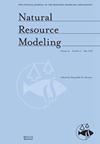Predicting soil hydraulic conductivity using random forest, SVM, and LSSVM models
IF 2.1
4区 环境科学与生态学
Q3 ENVIRONMENTAL SCIENCES
引用次数: 0
Abstract
Understanding the hydraulic properties of soil is essential to solve many management problems in agriculture and the environment. Water quality affects soil hydraulic conductivity. Soil hydraulic properties play an important role in nature's water cycle and are used as basic information in designing irrigation and drainage systems, hydrological issues, and soil quality assessment. In the current study, soil sampling is performed from different areas and its hydraulic conductivity was measured using the drop load method and then predicted using support vector machine (SVM) and least‐squares support vector machine (LSSVM) models. The model inputs were: soil texture (percentage of sand, silt, and clay particles), salinity (electrical conductivity), pH, sodium adsorption ratio, soil porosity, and bulk density and the output was soil hydraulic conductivity. Correlation coefficient, root mean square error (RMSE), mean bias error (MBE), and Nash–Sutcliffe efficiency (NSE) were used to evaluate the models and compare them. Based on evaluation criteria the best performance was obtained for random forest (RF) (利用随机森林、SVM 和 LSSVM 模型预测土壤导水性
了解土壤的水力特性对于解决农业和环境中的许多管理问题至关重要。水质会影响土壤的导水性。土壤水力特性在自然界的水循环中发挥着重要作用,是设计灌溉和排水系统、水文问题和土壤质量评估的基本信息。在当前的研究中,对不同地区的土壤进行了取样,并使用落载法测量了土壤的水力传导性,然后使用支持向量机(SVM)和最小二乘支持向量机(LSSVM)模型进行了预测。模型输入为:土壤质地(砂、粉砂和粘土颗粒的百分比)、盐度(导电率)、pH 值、钠吸附率、土壤孔隙度和容重,输出为土壤导水性。相关系数、均方根误差(RMSE)、平均偏差误差(MBE)和纳什-苏特克利夫效率(NSE)被用来评估和比较这些模型。根据评估标准,随机森林(RF)的性能最佳(R = 0.89,RMSE = 0.53,平均绝对误差(MAE)= 0.54,NSE = 0.72)。继 RF 模型之后,SVM 模型(R = 0.69、RMSE = 1.32、MAE = 0.69 和 NSE = 0.48)的性能优于 LSSVM 模型。
本文章由计算机程序翻译,如有差异,请以英文原文为准。
求助全文
约1分钟内获得全文
求助全文
来源期刊

Natural Resource Modeling
环境科学-环境科学
CiteScore
3.50
自引率
6.20%
发文量
28
审稿时长
>36 weeks
期刊介绍:
Natural Resource Modeling is an international journal devoted to mathematical modeling of natural resource systems. It reflects the conceptual and methodological core that is common to model building throughout disciplines including such fields as forestry, fisheries, economics and ecology. This core draws upon the analytical and methodological apparatus of mathematics, statistics, and scientific computing.
 求助内容:
求助内容: 应助结果提醒方式:
应助结果提醒方式:


